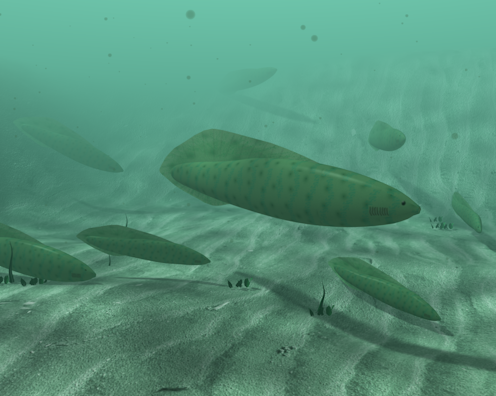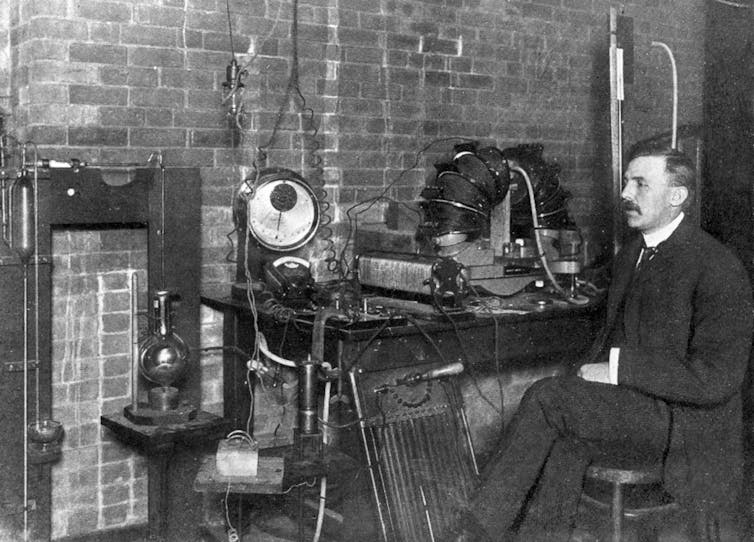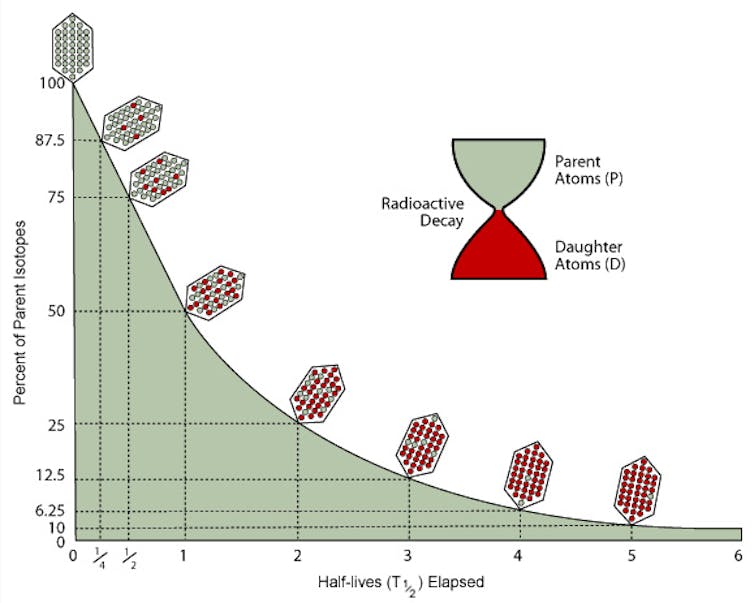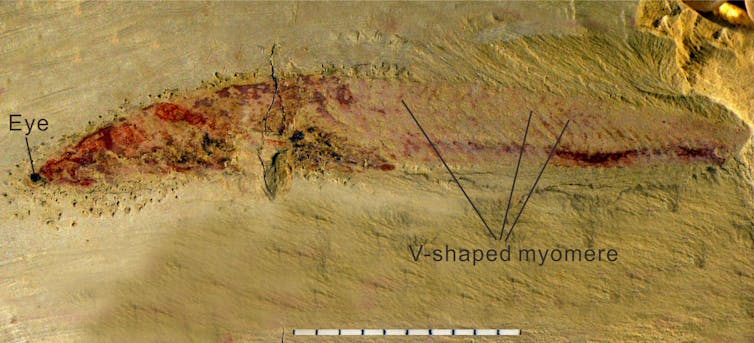

Curious Kids is a series for children of all ages. If you have a question you’d like an expert to answer, send it to curiouskidsus@theconversation.com.
How do you figure out how long ago fish were created? Hundreds of millions of years is a long time ago. – Josh, age 11, Ephrata, Pennsylvania
The oldest fossils of animals resembling a fish date back between 518 million and 530 million years ago. Discovered in China and called Haikouichthys, these animals were about an inch long (2.5 cm) and had a head with seven to eight slits at its base that looked like gills. They also had a distinct spine surrounded by muscles.
But there are ways Haikouichthys did not resemble any modern fish. For example, they didn’t have a jaw. Instead, their mouth was a cone-like opening similar to the ones seen in modern hagfish and lampreys. They also appear not to have had side fins.
Even though scientists like me weren’t around to see for ourselves what was happening on Earth so long ago, we use geologic clues to figure out what animals lived when. Here’s how we sort out very ancient timelines and even put dates on fossils like Haikouichthys.
Measuring in the millions
To figure out how long ago fish first appeared on Earth you need a way to measure really, really long time intervals. Clocks measure short intervals, like seconds, minutes and hours. Calendars measure longer intervals, like days, months and years. What can you use to measure millions of years?
Radiometric dating is the method that scientists use to calculate the passage of time in millions of years. To determine the age of rocks and fossils, scientists measure the type of atoms they are made of.
You might know that atoms are the building blocks of molecules, which make up everything around you – grass, cement, even air. While most atoms are very stable, some, called radioactive atoms, are unstable. Over long periods of time, they spontaneously break down into more stable atoms.
Uranium is one of these radioactive atoms. It breaks down very slowly into lead. Both uranium and lead atoms can be found naturally in rocks and minerals in very, very low amounts.
Nuclear physicists have calculated that it would take 700 million years for one pound of uranium to break down into half a pound of lead. This rate of decay occurs at such a predictable rate that scientists can use it to calculate fairly accurately how old rocks and fossils are.

The idea for radiometric dating first occurred to a New Zealand scientist named Ernest Rutherford in 1904. His idea was to measure the number of uranium atoms and lead atoms in a rock and compare them. He predicted that an older rock would have more lead and less uranium than a younger rock would.

The American scientist Bertram Boltwood put Rutherford’s idea to the test, measuring the amount of uranium and lead in different rocks collected from all over the world.
Once a rock is formed, no new elements are added to it. So scientists can calculate how much uranium the rock started with by adding what’s left to the amount of lead that’s there now, thanks to the radioactive decay process. Then, because they know exactly how long it takes for uranium to break down into lead, they can figure out the age of the rock. Boltwood proved that Rutherford’s idea worked, establishing the field of radiometric dating in 1907.
The making of the Haikouichthys fossil
Fossils are rocks. So scientists can use radiometric dating to estimate how long ago the organisms that left the fossil imprint lived on Earth.
Animals leave fossil imprints only under special circumstances. In order for the Haikouichthys to leave fossils, their dead bodies would have had to sink to the bottom of the water and be covered with sediments before microorganisms could decompose them. Then, minerals in the sediments would have seeped into the Haikouichthys for their remains to become fossilized.

Radiometric dating of Haikouichthys fossils suggests these animals were swimming in Earth’s waters between 518 million and 530 million years ago – and possibly longer.
Earth’s age as a 24-hour day
Scientists, using radiometric dating, estimate the Earth itself is 4.5 billion years old. For a long time on Earth, there was no life at all. Then microorganisms like bacteria showed up. It’s only relatively recently that plants and animals began living on Earth.
In fact, if you think of Earth’s age until now as a 24-hour day, it turns out Haikouichthys lived 2 hours and 45 minutes before the end of the day. Humanlike animals appeared even more recently on Earth – about 5 million to 7 million years ago – only a few minutes before the end of the hypothetical day.
Whether the Haikouichthys was the first fish or not remains controversial. There are very few other fishlike fossils from the same time period. But paleontologists keep digging. Who knows, maybe in a few years they will discover an even older fishlike animal that will dethrone Haikouichthys as the oldest fishlike creature.
Hello, curious kids! Do you have a question you’d like an expert to answer? Ask an adult to send your question to CuriousKidsUS@theconversation.com. Please tell us your name, age and the city where you live.
And since curiosity has no age limit – adults, let us know what you’re wondering, too. We won’t be able to answer every question, but we will do our best.
Isaac Skromne receives funding from National Science Foundation and National Institute of Health.
This article was originally published on The Conversation. Read the original article.







